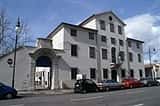Stay
Visit a locality browsing the menu on the left. In each Italy area you can then choose the best touristical structures we are proposing.
Most viewed in
Italy
-
Located on the famous AmalfiCoast drive, a few minutes from the famous town of Amalfi, the Santa Caterina enjoys a panoramic coastal setting of incomparable beauty. The history of this special resort is as impressive as its surroundings. In 1880, Giuseppe...
-
Situated on the last bend of Amalfi's promenade and beach, this hotel is on four levels. Bright and Mediterranean in style, the Marina Riviera is a converted old noble villa. All rooms are spacious & tastefully furnished, and have open windows or balconies...
-
Hotel Villa Maria - Amalfi's Coast - Ravello Owned by the Palumbo family, the Villa Maria Hotel offers to its guest the romantic atmosphere of the enchanting Ravello. It is located in a central position, in the historic center of the town, among Villa...
-
A path immersed in the colours and scents of abundant Mediterranean flora leads to the viewpoint of PuntaTragara in Capri, the setting for one of the most exclusive hotels in the world. Hotel PuntaTragara reigns over the most dramatically beautiful scenery,...
-
The Hotel Bellevue is a beautiful Mediterranean-style property, totally refurbished in 2007, surrounded by warm colored geranium and bougainvilleas, lush Mediterranean vegetation and lemon groves. It is located along the scenic "Strada Statale Amalfitana"...
Print this page
Send to a friend by e-mail
The Museum of the Sea
-

The Civic Museum of the Sea is one of the most important of its kind in the whole Mediterranean area, and is intended to show the importance of the sea in Trieste's history and the contribution made by Trieste and her people. From the panels about Trieste and Salt production, visitors come to the rooms dedicated to the inventor Marconi where a model of his ship - the Electra, from which the first wireless telegraph message was transmitted - can be seen, and to Ressel who carried out the first experiments into the use of the propeller in ships with a steam engine. The Museum dates back to 1888, when the Società di Pesca e Pescicoltura Marina began to plan what in 1904 became the Museum of Fishing, with connected laboratories for biological analysis. The collection of the Nautical School went on to form the Permanent Maritime Exhibition which found a home in the building in Via Campo Marzio in the Lazzaretto San Carlo, where today there are models of both primitive and mediaeval boats with explanatory panels about the evolution of boats and in particular of the development of those from the Mediterranean.
Point of interest
One of the most exciting sections of the Museum concerns the age-old method of extracting salt, which is based on a complex system of crystalisation basins and was used along the whole of the Adriatic coast. The display includes a model re-creating part of the salt-works at Semedella, near Capodistria.